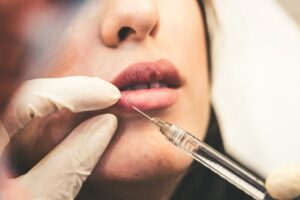
What Are Dermal Fillers?
Dermal fillers are injectable substances designed to restore volume and smooth out wrinkles. They enhance facial contours and provide a more youthful appearance. Unlike surgical options, dermal fillers offer a minimally invasive alternative with quick recovery times.
Types of Dermal Fillers
Different types of dermal fillers cater to various needs. Some of the most popular ones include:
- Hyaluronic Acid Fillers: The are the most common fillers. Hyaluronic acid, naturally found in the body, attracts and retains moisture, giving the skin a plump and hydrated look.
- Calcium Hydroxylapatite: This filler is heavier and denser, used for deeper wrinkles and folds. It stimulates collagen production, providing long-lasting results.
- Poly-L-lactic acid: This filler gradually stimulates collagen production. It’s often used to address facial volume loss and contour deficiencies.
- Polymethyl-Methacrylate Microspheres (PMMA): These provide a semi-permanent solution for deep wrinkles and folds. They consist of tiny beads suspended in a gel that stays under the skin.
Benefits of Dermal Fillers
Dermal fillers offer numerous benefits:
- Non-Surgical Solution: They provide a non-invasive alternative to plastic surgery.
- Immediate Results: Most patients see immediate improvements in their appearance.
- Versatility: Dermal fillers will address various issues, from smoothing out wrinkles to enhancing lips.
- Minimal Downtime: Recovery time is short, allowing patients to return to their routines quickly.
Artistry Clinic has a broad portfolio of treatments including wrinkle relaxing, facial dermal fillers, eye bag removal, non-surgical nose reshaping, world renowned skin care, lasers, Brazilian butt lifts, sexual function enhancement and more novel therapies such as PRP hair.
The Procedure
The dermal filler procedure is straightforward. Here’s what you can expect:
Consultation
The first step is to consult with a cosmetic surgeon or dermatologist. During this visit, you will discuss your goals, and the specialist will evaluate your facial anatomy. They will then recommend the best type of filler for your needs.
Treatment Day
On the day of the treatment:
- Preparation: The specialist cleans the injection site and may apply a topical anaesthetic to minimize discomfort.
- Injection: The filler is injected into specific areas using a fine needle. The number of injections depends on the desired outcome.
- Post-Treatment Care: After the injections, the specialist may massage the treated area to ensure even distribution.
Recovery and Aftercare
Recovery is typically quick. Patients might experience minor swelling or bruising, usually subsiding within a few days. Following post-treatment care instructions is crucial for the best results.
Risks and Side Effects
While dermal fillers are generally safe, they carry some risks:
- Allergic Reactions: Some patients may have allergic reactions to the filler material.
- Infection: Infections may occur if the injection site is not properly sanitized.
- Tissue Death: Rarely, fillers may block blood vessels, leading to tissue death.
- Other Complications: These include lumps, asymmetry, and skin discoloration.
Choosing the Right Practitioner
Selecting a qualified and experienced practitioner is vital. Look for board-certified dermatologists or cosmetic surgeons. Check their credentials and read reviews from previous patients.
Popular Areas for Dermal Fillers
Dermal fillers will enhance various facial features:
- Lips: Add volume and define the shape.
- Cheeks: Restore volume and create a youthful contour.
- Nasolabial Folds: Smooth out the lines running from the nose to the mouth.
- Marionette Lines: Address lines running from the mouth to the chin.
- Tear Troughs: Fill hollows under the eyes.
- Chin and Jawline: Enhance definition and balance facial proportions.
Comparing Dermal Fillers and Other Treatments
Dermal fillers offer unique benefits compared to other treatments:
- Botox: Botox relaxes muscles to reduce wrinkles, while fillers add volume.
- Facial Fat Grafting: Uses your own fat to restore volume but involves a more invasive procedure.
- Chemical Peels and Lasers: Improve skin texture and tone, but don’t add volume.
Cost and Longevity
The cost of dermal filler treatments varies based on the type of filler, the amount used, and the practitioner’s expertise. On average, prices range from $500 to $2000 per syringe.
Longevity
The longevity of dermal fillers depends on the type:
- Hyaluronic Acid Fillers: Lasts 6 to 18 months.
- Calcium Hydroxylapatite: Lasts up to 12 months.
- Poly-L-Lactic Acid: Results will last up to 2 years.
- PMMA: Offers semi-permanent results.
Future of Dermal Fillers
Research and innovation continue to enhance dermal filler technology. New formulations and techniques aim to improve safety, efficacy, and longevity. Patients may expect even more refined and personalized treatments in the future.
The Takeaway
Dermal fillers offer a versatile and effective solution for enhancing your appearance. Whether smoothing out wrinkles, adding volume, or defining facial features, an injectable dermal filler can meet your needs. Always consult with a qualified practitioner to ensure the best results and minimize risks. With advancements in filler technology, achieving a youthful and refreshed look has never been easier.
Injectable fillers, including hyaluronic acid and soft tissue fillers, provide immediate results with minimal downtime. The variety of dermal filler products allows customized treatments tailored to individual concerns, such as facial wrinkles or acne scars. By choosing the right type of filler and following proper dermal filler procedures, you can enjoy a natural and youthful appearance for months or even years.
Frequently Asked Questions
How long do dermal fillers last?
Dermal fillers typically last between 6 months and 2 years, depending on the type of filler used.
What is a dermal filler?
A dermal filler is an injectable substance used to restore facial volume, smooth wrinkles, and enhance facial contours.
What are the risks of dermal fillers?
The risks of dermal fillers include allergic reactions, infections, and rare complications like tissue death.
What is the difference between Botox and dermal fillers?
Botox relaxes muscles to reduce wrinkles, while dermal fillers add volume and smooth out facial lines through filler injections.






